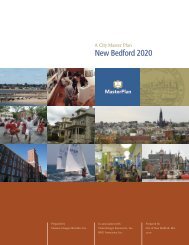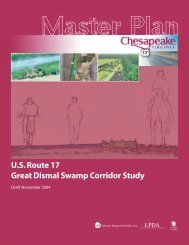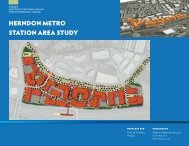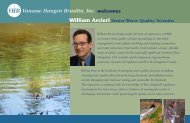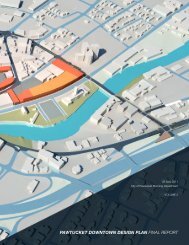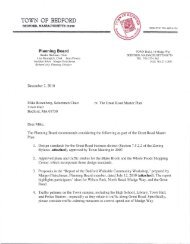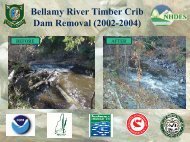Final Report - VHB.com
Final Report - VHB.com
Final Report - VHB.com
You also want an ePaper? Increase the reach of your titles
YUMPU automatically turns print PDFs into web optimized ePapers that Google loves.
leg of the intersection, which provides access to property on the south side of<br />
Pleasant Street that could present a redevelopment opportunity. This relocated<br />
intersection would be a roundabout or a signalized intersection.<br />
Strategy 2C - Improve Mobility along Mill Street<br />
Based on public input, there is little agreement about which actions should be taken<br />
to improve safety and mobility along Mill Street. Some people contend that as a<br />
principal arterial, Mill Street (i.e., US Route 1) should be widened to four lanes (i.e.,<br />
two lanes in each direction); others, stressing the proximity of the nearby residential<br />
neighborhood on the south side and the Androscoggin Brunswick-Topsham<br />
Riverwalk (with its recent restoration of the historic John A. Roebling Swinging<br />
Bridge) on the north side, believe that Mill Street should remain a two-lane roadway.<br />
In addition to the No Action Option, which maintains the existing two-lane cross<br />
section, three- and four-lane options were evaluated. The three-lane option consists<br />
of two northbound and one southbound travel lanes separated by a raised-center<br />
median. The basis for the three-lane section is that maintaining the single<br />
southbound lane (and the resulting delay) may encourage through traffic destined to<br />
I-295 to use the Coastal Connector. This perspective is consistent with the trafficcalming<br />
actions that are targeted for the Pleasant Street corridor. The four-lane<br />
option consists of two northbound and two southbound travel lanes separated by a<br />
raised-center median.<br />
To enhance pedestrian safety and provide the desired bicyclists and pedestrian<br />
connectivity, both the three- and four-lane options include sidewalks along Mill<br />
Street and construction of a pedestrian bridge in the vicinity of the existing railroad<br />
bridge. The pedestrian bridge essentially extends the Androscoggin Brunswick-<br />
Topsham Riverwalk to the residential neighborhood located on the opposite side of<br />
Mill Street.<br />
Strategy 3 - Extend the Existing Rail Spur to the NASB<br />
In keeping with the desire to consider opportunities for nonautomobile-oriented<br />
modes of access to the NASB, options were developed for extending the Rockland<br />
Branch Railroad spur - which currently runs along the north side of Bath Road - into<br />
the NASB. Two route options were developed for the spur, each of which provides<br />
rail access to the NASB near Hangar No. 6. The two route options consider crossing<br />
Bath Road either at grade or by way of grade separation where the rail spur crosses<br />
beneath Bath Road, resulting in four rail-spur options. The primary difference<br />
between the two route options is the origin of the spur on the Rockland Branch<br />
Railroad and the route to Hangar No. 6 on the NASB. The western alignment<br />
intersects Bath Road just east of Jordan Avenue; the eastern alignment intersects Bath<br />
Road just west of the Merrymeeting Plaza Shopping Center.<br />
Executive Summary 7



